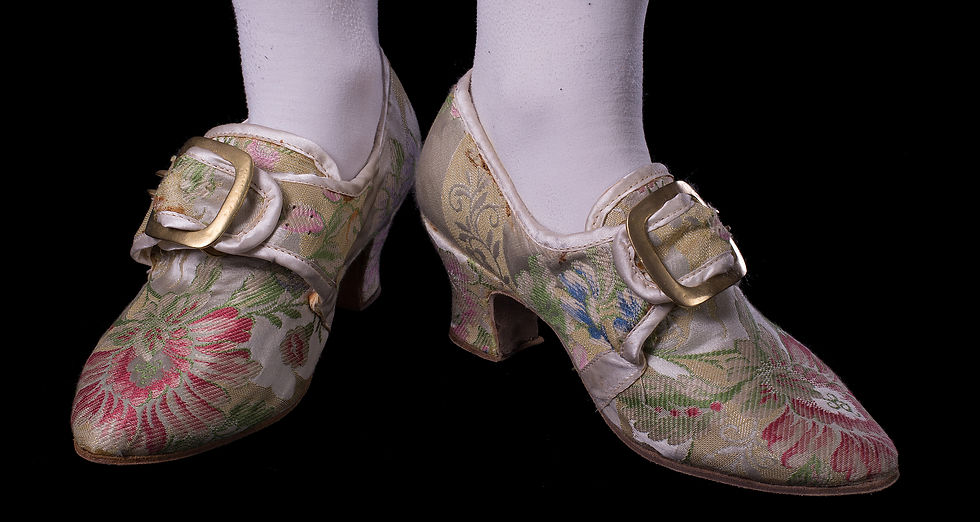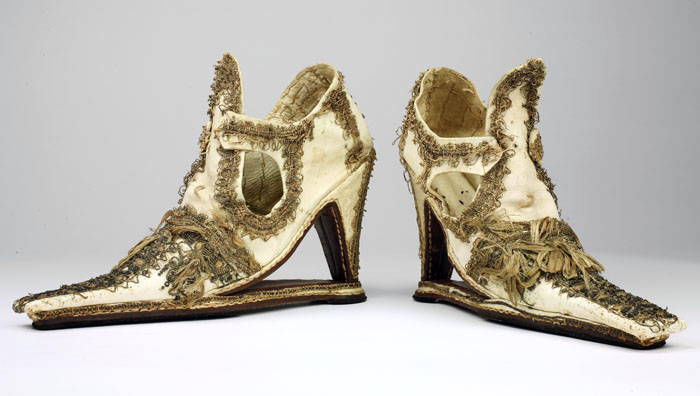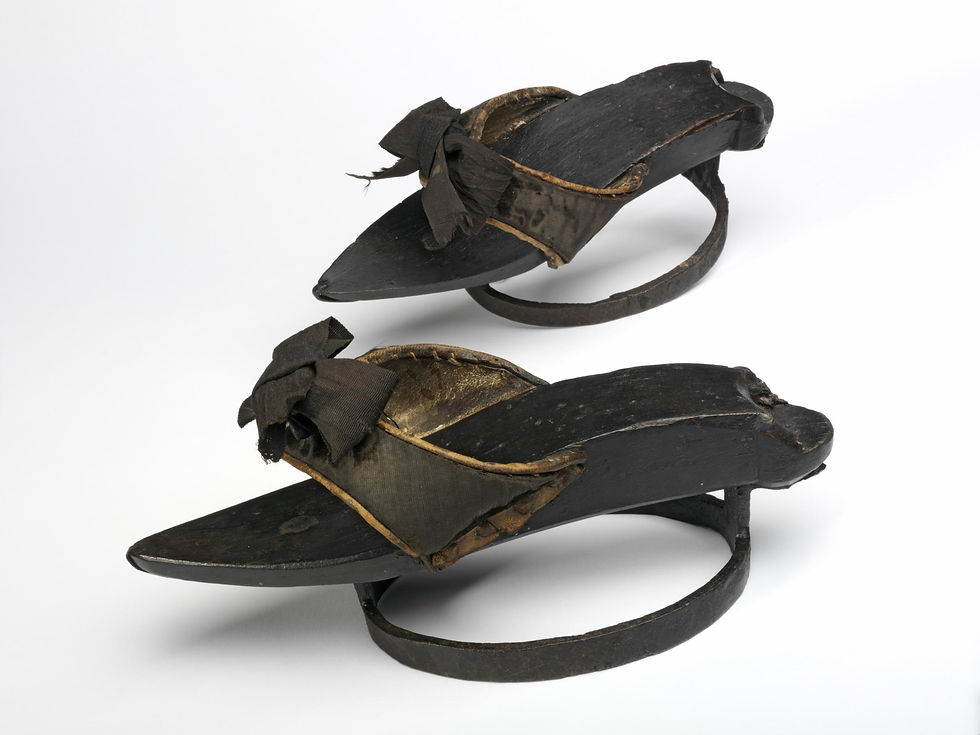17th Century Footwear
- Rani Jain
- Nov 27, 2018
- 6 min read
Updated: Jun 20, 2021
By the end of the sixteenth century, shoes began to change from slip-on styles to more snugly fitting tied styles. People took great care covering their feet during the seventeenth century. Fashionable footwear changed shape during the century, and middle-class and wealthy people eagerly purchased the new shoe styles in order to remain in fashion. Shoes and boots continued to be made on straight lasts, the basic sole pattern, so that a shoe would fit either foot. However, significant changes were made to shoe fastenings, toe shape, sole height, and the decorations applied to the upper, or tops of shoes.
During the seventeenth century shoes styles began to split along gender lines. Boots became quite fashionable for men during the century. By the middle of the century, men continued to prefer square-toed shoes, but women started to choose shoes with pointed toes. Some women wore a more elaborate pointed style, called hooked, with a pointed toe that curled upward.

Another style reserved for women's shoes was a white rand, a band of leather attaching the upper of the shoe to the sole. Before the seventeenth century, the rand of women's shoes was made of the same color as the sole of the shoe. White rands remained fashionable until the 1760s.

The narrow square toe and shaped heel of these shoes are typical of fashionable footwear of the 1660s and 1670s. The tongue and latchets (straps) have small holes, through which to draw a ribbon to tie the shoe, or to fasten with a buckle. The narrow red silk braid decorating this shoe has been used to spectacular effect. By applying it in rows set closely together, the braid accentuates the elegant, curvilinear shape of the shoe. The white rand, the narrow band of white kid around the edge of the sole, is characteristic of the late 17th century.
All shoes and boots had heels that were at least an inch high, and were more commonly two or three inches high, during the century. Although the shoes of the lower classes and working people were made of durable leather or wool, shoes of the wealthiest people were made with expensive fabrics or delicate leather and elaborate decorations.


Styles worn by both men and women were slippers, which were heeled slip-on shoes with no upper covering the heel, worn at home or for casual events, and overshoes worn over other shoes to protect them from inclement weather, dirt, and puddles.

Stylish women's mules or backless slippers. They are made of rich velvet embroidered with silver-gilt thread. From about 1550 to 1700, domestic embroidery became very fashionable and mules were often decorated in this way. This pair has a medium heel and a square, slightly overhanging toe. This makes them typical of luxury indoor wear for women in about the middle of the 17th century. A similar pair of mules was made for Queen Henrietta Maria, wife of Charles I.


Pantofles 17th century Pantofles were heelless slippers worn by women indoors. The earliest version of the shoe was made of cork, and later was made of leather.

Overshoes of this type were known as 'promenade' or 'carriage' clogs. The leather straps and square toe cap would have fitted over a woman's shoe or boot, protecting the fragile silks and kid leathers from dirt and damp. As the sole was made of cork, the carriage clog would have been light to wear.
· Heels
Height was a central feature of seventeenth-century fashion. People accentuated their height with tall hairstyles, long flowing gowns, long straight jackets, and high-heeled shoes. Introduced in the late sixteenth century as a wedged cork heel and adopted from the very high chopine, high-heeled shoes became the dominant style of footwear for both men and women during the seventeenth century. The heel of seventeenth-century shoes developed into an arched sole with a large square-based heel.

When heels were first added to shoes in the 1590s they were only about an inch in height. Heels towered two to three inches, although "well-heeled" women's skirts made their shoes virtually invisible. The heel expressed the status of the wearer as they were quite literally at a higher level than the hordes of common folk. Under Louis XIV, red heels were worn strictly at court, popularized red leather heels in the 1650s. Although this law existed only in France, by restriction the color came to represent the power and status of the aristocratic elite across Europe.

Heels were made of stacked pieces of leather or blocks of wood. The fanciest shoes covered the heels with the same fabric as the rest of the shoe, but brown leather coverings were most common. The decoration of shoes used many techniques: silk embroidery, applied cord passementerie, and silver and gold thread embroidery that was made by professional male embroiderers who belonged to embroidery guilds.

In addition to adding height, high-heeled shoes altered the posture and walk of the wearer. No longer could people stride casually without thought of their feet. Moving gracefully in high-heeled shoes took concentration and practice. High-heeled shoes forced people to thrust their upper bodies forward and take smaller steps. The stiffened posture and delicate movements required by such shoes fit right into the fashion of the times, which valued exaggerated manners. By the next century, children started to learn to walk in high-heeled shoes at an early age.
· Buckles
Originally, buckles came into fashion because of their utility. Buckled shoes began to replace tied shoes in the mid-17th century: Samuel Pepys, refers to putting on buckles for the first time, wrote in his Diary for 22 January 1660 "This day I began to put on buckles to my shoes, which I have bought yesterday of Mr. Wotton."

Samuel Pepys FRS was an administrator of the navy of England and Member of Parliament who is most famous for the diary he kept for a decade while still a relatively young man.
The fashion at first remained uncommon enough though that even in 1693 a writer to a newspaper complained of the new fashion of buckles replacing ribbons for fastening shoes. By the end of the seventeenth century, buckles overtook the standard of ribbon laces.

Standard ribbon laced shoes, 1680 - 1700. Description: Silk trimmed with rows of narrow gold braid having pointed toe, extended tongue, latchets tied with silk ribbon, tall Louis heel, faced in blue silk.

· Slap Sole Shoes
Slapping a flat sole to the bottom of a heeled shoe once had a purpose. Toward the beginning of the 17th century, men would place a sole on the bottom of their boots so that their heels wouldn’t sink in the mud. Eventually, the idea caught on with fashionable women’s shoemakers. While the sole was attached to the ball of the shoe, it was not fixed to the heel. Thus as women walked about, the clacking sound–one associated with wealth and sophistication–could not be avoided.


Possibly Italian; about 1670. Tan leather upper with band of olive silk with applied straw in decorative motif; narrow latchets cross over and tie thru narrow pointed tongue with green silk laces with tassels; butted side and back seams. Louis heel covered with mock galosh. Brown leather sole, tan leather insole. Clog: olive silk vamp and side of base with applied straw in floral and decorative motifs. Square pointed toe. Brown leather sole with flat heels at back and front, brown leather base top.
· Pattens
Pattens are over-shoes consisting of wooden soles, secured by leather straps and worn with boots or shoes to raise the wearer above the dirt when walking. The shape varied according to the period. Usually for country wear, but very fashionable in the 15th and 18th centuries; until the 17th century the term was synonymous with clogs. From ca. 1630 pattens were raised on iron rings: ‘The women leave in the passage their pattins, that is a kind of wooden shoes which stand on a high iron ring. Into these wooden shoes they thrust their ordinary leather or stuff shoes when they go out.’ - 1748, Pehr Kalm’s Account of his Visit to England, Stockholm, 1753. Trans. J. Lucas, 1892. Countrywomen continued to use pattens until the mid-19th century. They were often decorated by fabric matching the actual shoe. The pattens were taken off once in the house.

Giorgio Riello described this type as the most durably popular. Maker unknown (Great Britain). Pair of pattens, 1720s-1730s. Wooden sole, iron ring, and leather latchet fastenings covered with velvet. London, England: Victoria and Albert Museum, T.43&A-1932. Given by Miss F. R. Shipley.
Bibliography
Pendergast, Sara; Pendergast, Tom. Fashion, Costume, and Culture: Clothing, Headwear, Body
Decorations, and Footwear through the Ages. Michigan: U•X•L, 2004.
The Victoria and Albert Museum. Google Arts & Culture. <https://artsandculture.google.com/asset/
2gH0cf35VqZ-IQ?childassetid=SwGLRaRJtZJTXg>. November 25, 2018.
Walford, Jonathan. Love to Know. <https://fashion-history.lovetoknow.com/fashion-history-
eras/history-womens-shoes>. April 13, 2021.
Foster, John. Design Observer. <https://designobserver.com>. November 25, 2018.
Cumming, Valerie, C. W. Cunnington, and P. E. Cunnington. "Pattens." The Dictionary of Fashion
History. Oxford: Berg Publishers, 2010. 150. Bloomsbury Fashion Central. Web. 13 Apr. 2021. <https://www.bloomsburyfashioncentral.com/products/berg-fashion-library/dictionary/the-dictionary-of-fashion-history/pattens>.



Comments